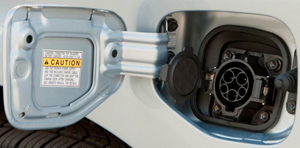Today, hybrids are everywhere. But what exactly is a “hybrid”? Technical definitions define hybrids as, “Any vehicle combining two or more sources of power which can directly or indirectly provide propulsion.” That can include diesel-electric hybrids as well as gasoline-electric ones. Common ground is the use of electricity, which is nothing new when it comes to automobiles. In fact, the first completely electric production vehicle was built by Thomas Parker in 1884. Years later in 1900, Ferdinand Porsche used electric motor technology to create the first hybrid vehicle with a gasoline engine generating power for electric drive motors at both front wheels.
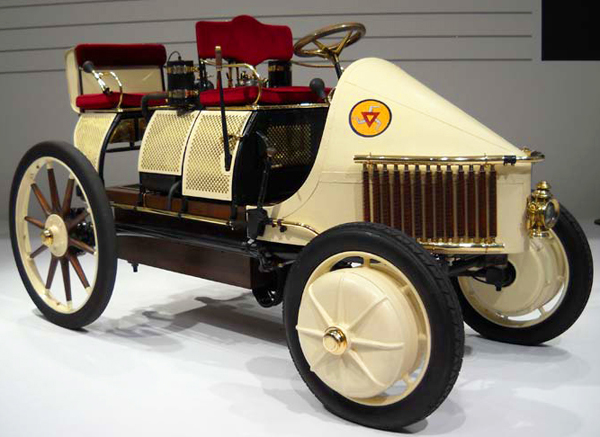
Although the first fully electric production vehicle dates back to 1884, the first hybrid vehicle (shown above) was created by Ferdinand Porsche in 1900 with a gasoline engine generating power for electric drive motors at both front wheels.
While partial and full-electric vehicles have seen minor interest over the years in spurts before World War I and during 1970s fuel crisises, only in the last ten years have they become practical enough to become popular. Although the motivation behind those that engineer and buy hybrid- or full-electric vehicles has always been better fuel economy and reduced pollution, manufacturers of supercars have recently realized strong performance gains from the instant torque electric motors provide.
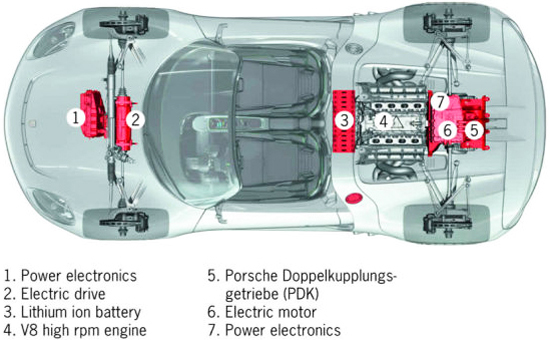
In recent years, manufacturers of supercars such as Porsche (918 model shown) have realized large performance gains from hybrid setups thanks to the instant torque electric motors provide.
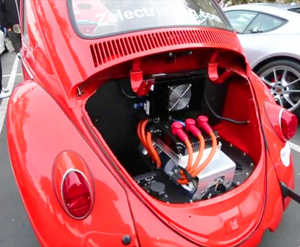
Companies that convert older combustion engine vehicles to an all-electric setup are seeing greater interest from the marketplace in recent years.
You’ll find gasoline-electric setups in current production Porsche 918s, McLaren P1s, and Ferrari LaFerraris (all achieving 0-60 times under 3 seconds) as well as upcoming Audi A8, Acura NSX, and BMW i8 models under development.
You’ll even find a high level of engineering when it comes to electric motor conversions on popular classic cars such as original Volkswagen Beetles (ZElectric Motors) and DeLoreans (new DeLorean Motor Company).
Current diesel-electric hybrids such as Volkswagen’s XL1 lightweight concept car powered by a compact electric motor and two-cylinder turbodiesel have documented over 300 miles per gallon, Volvo’s production V60 hybrid achieves 100 mpg, and full-size luxury cars such as Mercedes’ recently-introduced S-class hybrid have even been tested at 54 mpg. In this article, we’ll explore the types, layout, and general costs of hybrid and full electric vehicles. Because any type of hybrid may be equipped with either gasoline or diesel engines, we’ll group them together under the phrase “combustion” engines unless one is specifically being referenced.
TYPES OF HYBRID VEHICLES
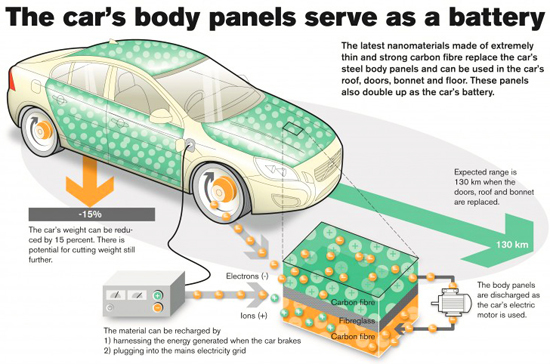
(Caption for above photo: The art and science of hybrid engineering is a work in progress that’s likely to see many more steps forward in the next decade. This picture illustrates how Volvo is working on body panels that double as battery storage to eliminate large amounts of weight and storage space typical battery packs require.)
Layouts of combustion and electric motors in hybrids vary greatly by manufacturer, and the art and science of hybrid engineering is a work in progress that’s likely to see many more steps forward in the next decade. The main types (and sub-types) of hybrids currently are:
PLUG-IN HYBRIDS – These are combustion-electric setups where a vehicle with large battery packs uses electric motors to drive the wheels most of the time. The vehicle is designed to charge by plugging into normal household current. In order to increase range, a combustion engine kicks in only as a backup if the battery runs down. There are two types of plug-in hybrids: Parallel plug-in hybrids and Series plug-in hybrids. (Example: Chevrolet Volt)
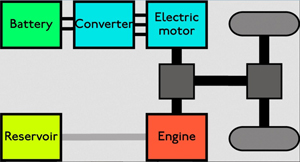 Parallel Hybrid – A combustion-electric setup where a combustion engine and an electric motor(s) are attached to one single transmission and can power the car at the same time. Under most driving conditions, both motors are active with electric-only operation occurring at low speeds. When the electric motor isn’t running, a generator sandwiched in between engines and transmission serves charge the battery. The electric motor is typically coupled to the engine at a spot where the flywheel would go, doubling as an electric starter when needed. This is more fuel efficient than other types of hybrid setups. (Examples: virtually all Toyota hybrids, the original Honda Insight, Chevrolet Malibu).
Parallel Hybrid – A combustion-electric setup where a combustion engine and an electric motor(s) are attached to one single transmission and can power the car at the same time. Under most driving conditions, both motors are active with electric-only operation occurring at low speeds. When the electric motor isn’t running, a generator sandwiched in between engines and transmission serves charge the battery. The electric motor is typically coupled to the engine at a spot where the flywheel would go, doubling as an electric starter when needed. This is more fuel efficient than other types of hybrid setups. (Examples: virtually all Toyota hybrids, the original Honda Insight, Chevrolet Malibu).
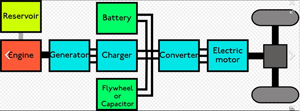 Series Hybrid – A combustion-electric setup where electric motors power the wheels fully and handle most driving. A small onboard combustion engine has no direct connection to the wheels and does nothing but recharge the battery pack. On short trips, the combustion engine may not even run at all. Larger electric motors necessitate battery packs which are larger, heavier, and more costly. (Example: Fisker Karma)
Series Hybrid – A combustion-electric setup where electric motors power the wheels fully and handle most driving. A small onboard combustion engine has no direct connection to the wheels and does nothing but recharge the battery pack. On short trips, the combustion engine may not even run at all. Larger electric motors necessitate battery packs which are larger, heavier, and more costly. (Example: Fisker Karma)
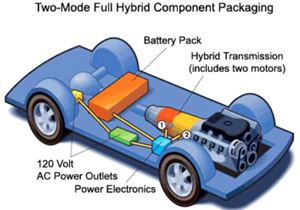 FULL HYBRID – A combustion-electric setup where combustion and electric motors are not sandwiched together. For example, a combustion engine may drive the front wheels through a traditional transaxle and electric motors may be mounted to the rear wheel hubs. Either type of motor is capable of propelling the drive wheels by themselves, and both engines can also work together when full power is needed. Under easy cruising and low-speed conditions, the electric motor will do all the work.
FULL HYBRID – A combustion-electric setup where combustion and electric motors are not sandwiched together. For example, a combustion engine may drive the front wheels through a traditional transaxle and electric motors may be mounted to the rear wheel hubs. Either type of motor is capable of propelling the drive wheels by themselves, and both engines can also work together when full power is needed. Under easy cruising and low-speed conditions, the electric motor will do all the work.
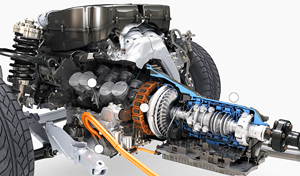 MILD HYBRID – A combustion-electric setup where the combustion engine propels the wheels at all times, with an electric motor assisting only when more power is needed. To save fuel, the combustion engine will shut off when the vehicle is stopped. After the driver releases the brake and applies throttle, the electric motor serve as a starter motor to fire up the compression engine once more. In mild hybrids, the electric motor is not capable of moving the vehicle on its own.
MILD HYBRID – A combustion-electric setup where the combustion engine propels the wheels at all times, with an electric motor assisting only when more power is needed. To save fuel, the combustion engine will shut off when the vehicle is stopped. After the driver releases the brake and applies throttle, the electric motor serve as a starter motor to fire up the compression engine once more. In mild hybrids, the electric motor is not capable of moving the vehicle on its own.
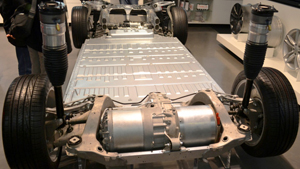
This view of a Tesla Model S shows how simple most pure electric vehicle layouts are. Here, electric motors power the rear wheels directly without a transmission.
PURE ELECTRIC – A vehicle that is not equipped with a combustion engine at all. Sole propulsion is achieved through electric motors that draw power from a large built-in battery pack which recharges by plugging in an electric cord. At the time of this writing, most pure electric vehicles have limited range of under 100 miles before recharging is needed. Thanks to advanced battery pack engineering, Tesla pure electric vehicles deliver 200-270 miles between charging.
TRANSMISSIONS ON HYBRID and ELECTRIC VEHICLES
The original 2000 Honda Insight was available with either a 5-speed manual transmission or a continually variable-rate transmission (CVT). Since its first Prius debuted in the Japanese market in 1997, Toyota has favored hybrid setups with CVT transmissions that can be driven by either combustion or electric motors. Typically, CVTs are the norm on hybrids and some pure electric vehicles such as the Nissan Leaf. It’s interesting to note that vehicles engineered more recently with electric motors driving the wheels like the current Honda Accord Hybrid and Tesla S feature no transmissions at all because electric motors can spin at over 14,000 rpms.
WAYS THAT HYBRIDS ACHIEVE EFFICIENCY
Combustion engines are designed to be big and powerful enough to deliver peak power and great 0-60 times when the accelerator pedal is floored. Even though that kind of driving is done less than 1% of the time, powerful engines still guzzle fuel 100% of the time they’re running. Most vehicles need only 25 horsepower to maintain a steady cruising speed.
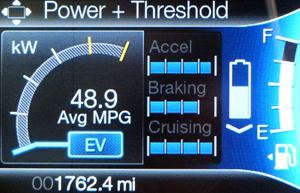
This photo of a Ford Fusion hybrid economy gauge allows a look at how typical hybrids use and display many fuel-saving techniques, such as regenerative braking.
Hybrids gain much of their efficiency by using smaller combustion engines sized for the lower horsepower demands of average driving. For example, many family sedans and sport utilities that would usually be equipped with a V6 of 3.0 to 4.0 liters are now fitted with 4-cylinder engines averaging 2.0 liters in size. Horsepower and torque lost due to smaller combustion engine displacement is often compensated by electric motors that provide boost only when needed.
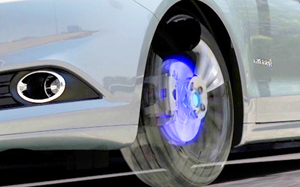
It’s estimated that most hybrids capture up to 90 percent of energy normally lost through heat during braking and use it to recharge the battery through electrical motor resistance.
In addition to traditional brakes, hybrids also use a regenerative braking effect when on-board sensors detect the vehicle is slowing. The physical resistance electric motors naturally have when they’re not powering the vehicle allows them to act like a generator and recharge the battery. Hybrids use tires formed from a stiffer rubber compound than most, and those tires are specified for inflation to a higher psi. While these factors may result in a stiffer ride, this type of “eco-plus” tire has much lower rolling resistance and creates roughly half as much drag as traditional tires do.
Hybrids with a combustion engine shut the engine down at slow speeds or when the vehicle is stopped, so no fuel is wasted from an idling engine. This adds up to significant savings over time. In fact, many manufacturers of combustion-only vehicles now design their engines to temporarily shut off at stop lights. Since combustion engines in many hybrids are designed to be secondary power sources, those engines are designed to run at lower maximum rpms to allow for use of lighter internal engine components which improve efficiency. The Tesla Model S even goes into brake regenerative mode immediately after the accelerator pedal is released.
REAL COST SAVINGS OVER A TRADITIONAL HIGH-MPG GASOLINE VEHICLE
Pure hybrids and hybrids that do more of their driving through electric motors require large, expensive battery packs. Comparing suggested retail prices of gas-only and hybrid versions of the same make and model may result in sticker shock once you realize fuel-saving hybrids typically cost $4,000 to $8,000 more.
With that kind of extra cost up front, figuring out how much money a hybrid will save gets trickier. Realizing how off-putting higher sticker prices of electric vehicles can be, the U.S. Federal government has enacted a tax credit for buyers of pure electric and hybrid-electric vehicles ranging from $2,500 to $7,500 based on battery capacity. For more details on specific makes and models, the U.S. Department of Energy’s Tax Incentives Information section is an excellent source of information. Their website also features a comparison calculator which allows a visitor to compare any hybrid model of their choice to a non-hybrid version of that same model, or to a completely unrelated one.
In a 2013 study by U.S. News & World Report, gas and hybrid-electric versions of five popular models were compared using then-current gasoline prices of $4 per gallon and an average of 15,000 miles driven per year. They found a hybrid version of the Volkswagen Jetta cost $8,300 more than the base model, added 156 miles to the range, added 55 horsepower, and saved $800 annually on fuel (42/48 mpg vs. 23/29). A Ford Fusion hybrid cost $5,500 more, added 185 miles to the cruising range, added 13 horsepower, and saved $850 annually on fuel (47/47 mpg vs. 22/34). A Toyota Highlander SUV hybrid cost $8,275 more than a V6 4-wheel-drive model, added 105 miles to cruising range, added 10 horsepower, and saved $860 annually on fuel (28/28 mpg vs. 17/22). Interestingly, Lincoln priced their MKZ hybrid the same as their V6 gas model. The hybrid added 181 miles to cruising range, lost 52 horsepower to the gas version, and saved $800 annually on fuel (45/45 mpg vs. 19/28).
According to TrueCar Data firm, the fuel savings of a Ford Fusion hybrid would take six and a half years to offset its higher sticker price if gasoline cost $5 a gallon, and eight and a half years at $4. If gasoline were to climb to $6 per gallon, hybrid Hyundai Sonatas, Toyota Camry, and Kia Optimas would lead the way with a payback period of only four years. TrueCar also calculates a buyer selecting a Nissan Leaf pure electric vehicle over a similarly sized Nissan Versa gas model wouldn’t see a payback for eight and half years at $4 per gallon, and six years at $5 per gallon.
INTERPRETING EPA ECONOMY RATINGS ON HYBRIDS
For electric vehicles and hybrids that plug into an outlet, the traditional miles per gallon (MPG) economy rating doesn’t apply because few, if any, gallons of fuel are used to power the vehicle. Instead, the United States Environmental Protection Agency began assigning multiple ratings to these vehicles found on new car window stickers since 2010: kilowatt-hours per 100 miles (kWh/100m); mpg-equivalent (MPGe); combustion engine economy (if applicable); annual electricity cost; and cruising range.
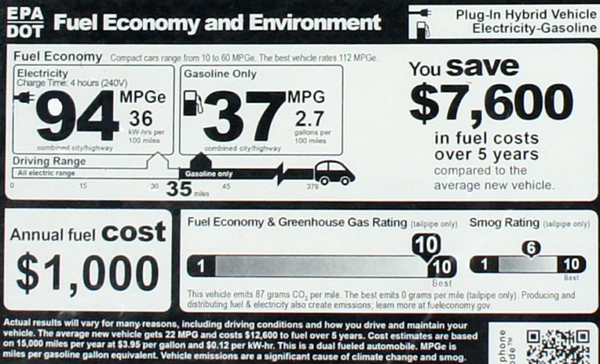
By law, a window sticker for any hybrid or electric vehicle must show kilowatt-hours per 100 miles (kWh/100m), mpg-equivalent (MPGe), combustion engine economy (if applicable), estimated annual electricity cost; and cruising range.
First, kilowatt-hours per 100 miles are based on a formula where 33.7 kilowatt hours equal one gallon of gasoline. Because the house or building you’ll plug your vehicle into for charging is also billed in kilowatt hours, this makes it easier to figure typical dollar costs you’ll face.
An “MPGe” rating signifies how many miles the vehicle can go using the same energy content as a gallon of gasoline, with a small “e” designating energy content. This formula uses a common standard where 115,000 BTUs equal the heat energy that would be generated by burning one gallon of gasoline. Vehicles that can run on either electric or combustion are required to display both an MPGe rating (shown on a miles per gallon format) and a traditional MPG rating for the gasoline engine on its own.
The EPA calculates electric vehicle range by starting with a full charge and driving over their specially designed city-highway test track until the vehicle’s battery is fully spent. The number of miles the vehicle traveled in that test is multiplied by 90 percent because they assume most batteries only reach a 90% charge level. As with any economy measurement, how the user operates the vehicle will greatly affect real-world range.

